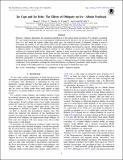| dc.contributor.author | Rose, Brian E. J. | |
| dc.contributor.author | Bitz, Cecilia M. | |
| dc.contributor.author | Cronin, Timothy Wallace | |
| dc.date.accessioned | 2018-04-27T13:46:59Z | |
| dc.date.available | 2018-04-27T13:46:59Z | |
| dc.date.issued | 2017-08 | |
| dc.date.submitted | 2017-05 | |
| dc.identifier.issn | 1538-4357 | |
| dc.identifier.uri | http://hdl.handle.net/1721.1/114986 | |
| dc.description.abstract | Planetary obliquity determines the meridional distribution of the annual mean insolation. For obliquity exceeding 55°, the weakest insolation occurs at the equator. Stable partial snow and ice cover on such a planet would be in the form of a belt about the equator rather than polar caps. An analytical model of planetary climate is used to investigate the stability of ice caps and ice belts over the widest possible range of parameters. The model is a non-dimensional diffusive Energy Balance Model, representing insolation, heat transport, and ice-albedo feedback on a spherical planet. A complete analytical solution for any obliquity is given and validated against numerical solutions of a seasonal model in the "deep-water" regime of weak seasonal ice line migration. Multiple equilibria and unstable transitions between climate states (ice-free, Snowball, or ice cap/belt) are found over wide swaths of parameter space, including a "Large Ice-Belt Instability" and "Small Ice-Belt Instability" at high obliquity. The Snowball catastrophe is avoided at weak radiative forcing in two different scenarios: weak albedo feedback and inefficient heat transport (favoring stable partial ice cover), or efficient transport at high obliquity (favoring ice-free conditions). From speculative assumptions about distributions of planetary parameters, three-fourths to four-fifths of all planets with stable partial ice cover should be in the form of Earth-like polar caps. | en_US |
| dc.publisher | IOP Publishing | en_US |
| dc.relation.isversionof | http://dx.doi.org/10.3847/1538-4357/AA8306 | en_US |
| dc.rights | Article is made available in accordance with the publisher's policy and may be subject to US copyright law. Please refer to the publisher's site for terms of use. | en_US |
| dc.source | IOP Publishing | en_US |
| dc.title | Ice Caps and Ice Belts: The Effects of Obliquity on Ice−Albedo Feedback | en_US |
| dc.type | Article | en_US |
| dc.identifier.citation | Rose, Brian E. J. et al. “Ice Caps and Ice Belts: The Effects of Obliquity on Ice−Albedo Feedback.” The Astrophysical Journal 846, 1 (August 2017): 28 © 2017 The American Astronomical Society | en_US |
| dc.contributor.department | Massachusetts Institute of Technology. Department of Earth, Atmospheric, and Planetary Sciences | en_US |
| dc.contributor.mitauthor | Cronin, Timothy Wallace | |
| dc.relation.journal | Astrophysical Journal | en_US |
| dc.eprint.version | Final published version | en_US |
| dc.type.uri | http://purl.org/eprint/type/JournalArticle | en_US |
| eprint.status | http://purl.org/eprint/status/PeerReviewed | en_US |
| dc.date.updated | 2018-04-23T19:20:22Z | |
| dspace.orderedauthors | Rose, Brian E. J.; Cronin, Timothy W.; Bitz, Cecilia M. | en_US |
| dspace.embargo.terms | N | en_US |
| dc.identifier.orcid | https://orcid.org/0000-0002-7807-2878 | |
| mit.license | PUBLISHER_POLICY | en_US |
